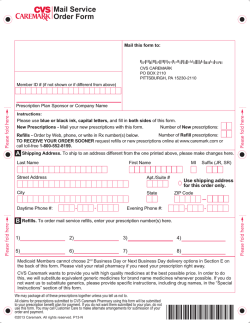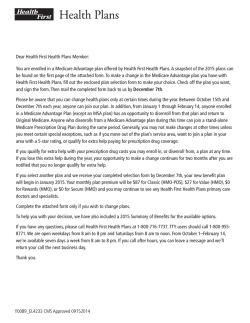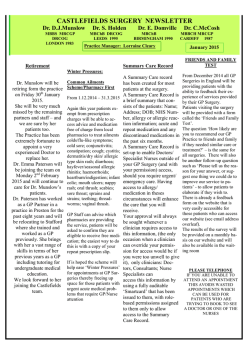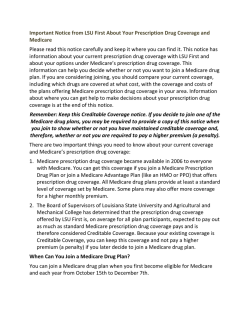
Guidance for Prescription Security in Primary Care
Guidance for Prescription Security in Primary Care Information for GP Practices Pharmacy and Medicines Management Team V8.0 January 2015 Contents 1. Introduction…………………………………………………................3 2. Prescription Security Procedures and Protocols…………………...3 3. Register of Prescriptions Forms…………………………………….. 4 4. Ordering New Prescription Forms ................................................ 5 5. Receipt of Prescription Forms ...................................................... 6 6. Issue of prescription Forms .......................................................... 7 7. Storage of Prescription Forms ……………………………………….7 8. Signed Forms awaiting collection……………………………………..8 9. Private Prescriptions PCD1……………………………………………9 10. Stock Prescriptions ..................................................................... 9 11. Stolen/ Missing Prescriptions………………………………………10 12. Preventing the alteration of written prescriptions………………...11 13. Additional guidance for dispensing doctors ............................... 11 14. Disposing of obsolete prescription forms………………………….11 15. Audit of prescription security……………………………………….12 16. Appendices …………………………………………………… 13-22 2 1. Introduction Theft and misuse of blank or legitimately completed prescriptions signed by an authorized practitioner is an area for concern as these forms can be used to obtain drugs, often controlled drugs, illegally for recreational use, unsupervised treatment of an illness or health condition, or for onward sale. Given current problems with drug misuse across Northern Ireland and potential adverse effects on the prescribing budget, it is essential that all prescribers and other staff who handle prescription forms are vigilant in adhering to procedures that reduce the risk of prescription theft and misuse. There are already a number of security measures that have been built into prescription forms to prevent theft and fraudulent use such as ultraviolet markings, coloured backgrounds and serial numbers. These are less effective if poor security measures allow theft of the forms in the first instance. The effective management of prescription forms e.g. how they are stored and accessed by authorized prescribing and non-prescribing staff is very important and there should be appropriate security policies, procedures and systems in place in each practice. This guidance has been designed to assist practices in developing their own procedures and systems to ensure the security of prescription forms held within the practice and by practitioners when attending patients outside of their practice. 2. Prescription Security Procedures and Protocols The Practice should have a written protocol signed up to by all staff outlining procedures for the management of prescription security on all practice sites e.g. in a branch surgery A register should be maintained on each site detailing information about prescriptions ordered, received and taken for use 3 Nominated person(s) should be appointed to take responsibility for prescription security procedures e.g. Practice Manager (PM) & Clinical Governance Lead (CGL) All staff should be made aware of prescription security procedures through training. A list of those staff members trained and date of training must be kept. Processes must be in place to ensure that new staff, locums and GP trainees are made aware of the procedures. Only appropriately trained staff should be allowed to generate prescriptions Passwords should not be shared. Computer generated prescriptions can be identified by an audit trail An annual review should be carried out to ensure appropriate systems are in place, and are being adhered to. The following issues should be considered when developing procedures for HS21, stock and PCD1 prescription forms and in the day-to-day management of prescription forms 3. Register of Prescription Forms A register formally recording the ordering, receipt and issue of prescription forms must be kept. Serial numbers for prescriptions received and issued should be recorded. See Appendices 1-5. A register should include details of the following for each prescriber /Cypher number: - Date of order and name of person placing the order - Number of prescriptions ordered - Name of person who received and stored prescriptions and date received - Quantity/Serial numbers of prescriptions received - Name of prescriber on the prescription - Date, quantity and serial numbers issued for use - Person who removed from store - Prescriber (or prescription terminal) they will be used by. 4 Separate sections should be kept for each type of prescription form e.g. computer (Appendix 1), handwritten (Appendix 2), stock (Appendix 3) and PCD1 forms (Appendix 4). Separate pages should be used for each prescriber including non-medical prescribers. A log should be kept of prescriptions issued to all prescribers who do not have their own Cypher number. See Appendix 5 4. Ordering New Prescription Forms All NHS prescriptions should be ordered from DLRS (NI) Ltd, including those for doctors, nurse prescribers and pharmacist prescribers. Order forms can be downloaded from the Business Services website www.hscbusiness.hscni.net/services/1944.htm DLRS (NI) Ltd will only deliver to the main surgery address and will not deliver to branch surgeries. If practices have branch surgeries, it is the responsibility of the practice to arrange the secure transport of prescription pads to these locations. A standard operating procedure covering the transportation to branch surgeries should be in place and all staff made aware of this. It is important that if prescriptions are transported via car, they should be stored out of sight e.g. in a locked boot. For GPs the following types of prescriptions are available: Computer sheets (HS21CS) – prescriptions to be used in a printer. These should be used by all prescribers who can log onto the prescribing system. They contain a 2 dimensional bar code which contains the practice details. Handwritten sheets (Dr Pad HS21, Minimum order 400 sheets) – these are unique to the prescriber and should be ordered in the minimum quantity. They contain details of the prescriber’s name, address and Cypher number. Stock sheets (HS21S, Minimum order quantity 100 sheets) these are used to order stock items (maximum of 8 items per form) and should be ordered for each GP who holds CDs or provides the services that require stock items. The forms have a 2D barcode on the bottom left hand side of the form which 5 contains the GP cypher, the form type and a unique 11 digit form number. PCD1 sheets (PCD1, Minimum order quantity 25 sheets) – these are used to supply private prescriptions for Schedule 2 and 3 controlled drugs. If a supply of PCD1 forms is required the prescriber must complete a PCD1 application form. This form can be downloaded from the Business Services Organisation website http://www.hscbusiness.hscni.net/services/2272.htm The completed application form should be sent to the following email address: [email protected] or alternatively a signed hard copy can be sent to the address on the form. HSCB staff will review all applications for PCD1 forms and, if approved, will ask BSO staff to order a supply of PCD1 forms. These will be delivered to the practitioner within approximately two weeks. In the event that further forms are required, applicants should reapply using this same process as for the initial supply of PCD1 forms An acceptable stock level should be set for each type of prescription for each practitioner and orders placed accordingly. Forms should be ordered only by nominated person(s), by post or fax, using the correct order form. Entries should be made on the appropriate pages of the register as outlined in Section 3. A copy of the order form should be kept in a designated file. If a delivery is not received, DLRS (NI) Ltd should be contacted via their helpdesk (Tel: 028 92622999). 5. Receipt of Prescription Forms Deliveries should be signed for by a nominated and trained member of practice staff. As this signature is obtained electronically by the courier and there is no paper delivery note, it is important that the delivery is checked against the original order to ensure it has been delivered to the correct address for the practice and is for the correct practitioner(s). Prescription forms should not be left at an 6 alternative address (e.g. neighbour) for onward delivery to the practice later. The person signing for the delivery should ensure the person who placed the order is informed. Entries should be made on the appropriate pages of the register as outlined in Section 3: 6. Issue of prescription forms When a new supply of prescriptions is issued for use to a prescriber or terminal, entries should be made on the appropriate pages of the register as outlined in Section 3. A limited number of handwritten forms should be issued to prescribers. For locums and GP trainees, these should be from a pad for the GP whose Cypher number the prescriber is working under. Unused forms must be returned at the end of any employment period (e.g. day or week). The returned formed should be returned to secure storage and a record made in the register (Appendix 5a). 7. Storage of Prescription Forms Unused forms should be kept in a secure locked area to which access is kept to a minimum number of nominated people A named person (PM or CGL) should be responsible for checking prescription storage and registers at regular intervals. This should include obtaining assurances from all prescribers working regularly in the practice, including GP trainees and locums, that unused forms in their possession are still secure. Forms should be stored in chronological order of delivery to facilitate audit/review For handwritten and stock forms, it is good practice for only one working pad per GP/ Practitioner to be in use at any one time For PCD1 forms it is good practice for only one prescription form per GP/Practitioner to be taken for use at any one time A limited number of forms should be taken for home visits or other use outside the practice Forms should not be left unattended or unsecured at any time in the practice or in a car. All forms, including handwritten 7 forms, should be kept in a locked drawer/cabinet in the practice when not in use and in a locked bag when removed from the practice. In exceptional cases when handwritten/stock forms are necessary in consulting rooms, these should be secured when a practitioner leaves the room regardless of the reason or length of time. If computerised prescriptions need to be removed from the printer e.g. when another prescriber is using the room, they should be securely stored. 8. Signed Forms awaiting collection Where a pharmacy prescription collection service is operational, only designated members of the pharmacy staff should collect prescriptions and this should be documented in the practice’s prescription collection policy. A record should be kept of prescriptions collected on behalf of patients to ensure an audit trail is available. Where prescriptions are collected by a third party e.g. taxi driver on behalf of a pharmacy, the practice should endeavour to place a tamper-evident seal (such as a sticker stamped with the practice name and address) on the envelope. Signed forms must be stored where they cannot be accessed by the public and removed from the counter to a secure drawer if practice staff are not at the counter. Uncollected prescriptions should be locked away securely at the end of each day On no account should a box of signed prescriptions be handed to a person who is not a member of practice staff to find a prescription e.g. community pharmacy collection staff Measures should be taken to determine the identity of the person collecting a prescription as documented in the practice’s acute/repeat prescribing protocol, especially for prescriptions for medication liable to abuse or where large numbers of prescriptions are collected by one person Ideally prescriptions should not be posted. However, if this is necessary, systems should be in place to minimise risk. If no other method of prescription transfer is available and consent 8 has been obtained from the patient (and documented in their notes), then a secure postal service is recommended i.e. ‘Special Delivery’ mail. A record should be kept of all prescriptions posted. It is good practice to obtain a signature from the person collecting prescriptions for Schedule 2 and 3 controlled drugs to facilitate an audit trail A procedure should be in place to ensure that uncollected prescriptions are destroyed promptly, usually a month after issue, and a record made in the patient’s notes. 9. Private CD Patient Prescribing (PCD1s) Forms Private prescriptions for Schedule 2 and 3 CDs (including temazepam and tramadol) must be written on a standard private prescription form i.e. PCD1 form and the prescription should be written in line with CD prescription requirements. Not all practices or prescribers will require PCD1 forms and they should only be ordered if there is an ongoing need for them in the practice. See section 4 Ordering New Prescription Forms for details on how to order these forms. 10. Stock Prescriptions The ordering and receipt of stock prescriptions for NHS purposes (NHS21S forms) should be recorded in the same way as other prescription forms It is recommended that only one pad of HS21S forms per GP is ordered at a time. Each GP with Cypher number should use their own HS21S stock order forms to order stock drugs Locums, trainees and other GPs without their own Cypher number may also require stock drugs, including controlled drugs. This may be facilitated by using another GP’s HS21S stock form. Authorisation for this should be given by the GP whose name appears on the HS21S form. The form should be signed by the locum, trainee or other GP for whom the stock is intended and their name written in block capitals on the line indicated. Stock prescriptions should be subject to the same safe storage requirements as other prescription forms 9 Bottom (yellow) copy of stock prescription should be retained by practice for a minimum of two years and stored in designated file for future reference It is good practice to use this copy as a check to ensure that all ordered items have been received. It should be signed to confirm receipt and retained in the practice. Requisitions to obtain CD stocks for private purposes should be made using headed notepaper and written in line with CD requisition requirements 11. Stolen/ Missing Prescriptions Theft of prescriptions can occur with either blank and/or completed prescriptions and as such prescription security requires constant vigilance. If a stolen prescription is presented for dispensing, this is a false representation and will become a fraud investigation. If prescriptions are stolen or missing, the practice should notify: Local Medicines Management Office, HSCB AND CFPS Fraud Hotline (Tel: 08000 0963396) Local district police station. Ring 0845 6008000 to get local office number Nurse prescribers employed by the Trusts must also inform their nurse manager. Missing/Stolen prescriptions for Controlled Drugs must always be reported to the HSCB Accountable Officer by contacting your local medicines management office. Assume “lost” prescriptions are stolen until evidence is available to the contrary. There is an obligation on each prescriber to check if the volume of their own handwritten pad is going down unexpectedly. The risk of forms being stolen or going missing can be reduced if they are taken out of store only a few at a time. 10 12. Preventing the alteration of written prescriptions Prescriptions obtained in good faith by members of the public can be fraudulently altered in two ways, the number associated with the medication to be dispensed is altered to increase the quantity or strength extra medication is added to the prescription. The patient may either be obtaining the medication to consume themselves or to sell onto others. In order to prevent the unauthorised addition of medication it is recommended that the GP clinical system is configured to ensure the unused section of the prescription form is printed over to prevent additions e.g. endorsed with a large X. 13. Additional guidance for dispensing doctors When submitting prescription forms for payment to the BSO dispensing doctors must ensure that they use the correct form of transport e.g. recorded delivery. They must not use forms of transport that are intended for purposes other than the transportation of prescription forms e.g. medical records courier. 14. Disposing of obsolete prescription forms In some circumstances, blank prescription forms will become obsolete and must be destroyed, for example: There is a practice split, all forms should be destroyed and new prescriptions for the new practices used The prescriber leaves or retires from the practice or Prescribing status is withdrawn for any reason Obsolete prescription forms should be destroyed according to the practice’s confidential waste policy and records kept of the destruction. 11 A record should be kept of forms destroyed (including start and end serial numbers), date and method of destruction, signature of authorising GP and signature of person doing the destroying. Nurse prescribers employed by HSC Trusts must return unused prescriptions to their employer. 15. Audit of prescription security A nominated individual (PM or CGL) should carry out a monthly reconciliation of the prescription register. Forms held by long term locums, GP trainees, salaried GPs and NMPs should be included in this check. An annual audit of prescription security using the HSCB Audit Tool is also recommended. http://primarycare.hscni.net/pdf/prescription_security_audit_May_201 1.pdf Any adverse incident should be reviewed promptly by relevant members of the practice team and appropriate actions taken, including notification of other agencies as required (see section 10). An adverse incident form should be completed and submitted to the HSCB to allow learning from incidents to be shared. http://primarycare.hscni.net/risk_management.htm 12 APPENDIX 1a COMPUTER PRESCRIPTIONS RECEIVED Prescriber Name _________________________ Cypher Number: _____________________ Date Ordered Number Date Serial numbers ordered by ordered received Stored by 13 APPENDIX 1b COMPUTER PRESCRIPTIONS ISSUED Prescriber Name: _______________________ Date taken for use Serial numbers (from- to) Taken by Cypher Number: ________________ Destination e.g. Printer 1 Serial Numbers Returned 14 APPENDIX 2a HANDWRITTEN PRESCRIPTIONS RECEIVED Prescriber Name: ___________________________ Date Ordered Number Date Serial numbers ordered by ordered received Cypher Number: _______________ Stored by 15 Appendix 2b HANDWRITTEN PRESCRIPTIONS ISSUED Prescriber Name: ________________________ Date taken for use Serial numbers (from- to) Cypher Number: ________________ Taken by Given to (GP name) 16 Appendix 3a STOCK PRESCRIPTIONS RECEIVED Prescriber Name: ______________________ Cypher Number: __________________ Date Ordered Number Date Serial numbers ordered by ordered received Stored by 17 Appendix 3b STOCK PRESCRIPTIONS ISSUED Prescriber Name: _______________ Date taken for use Serial numbers (from- to) Cypher Number: ____________________ Taken by Given to (GP name) 18 Appendix 4a Private Controlled Drug PCD1 Prescriptions received Prescriber Name: ______________________ Cypher Number: __________________ Date Ordered Number Date Serial numbers ordered by ordered received Stored by 19 Appendix 4b Private Controlled Drug PCD1 Prescriptions issued Prescriber Name: _______________ Date taken for use Serial numbers (from- to) Cypher Number: ____________________ Taken by Given to (GP name) 20 Appendix 5a Handwritten Prescriptions issued to Other Prescribers who do not have a Cypher number Date taken for use Serial numbers From To Name of Issued to: practitioner on form GMC Number (or equivalent for other prescribers) Serial numbers used Serial numbers returned Date returned / checked by 21 Appendix 5b Stock Prescriptions issued to Other Prescribers who do not have a Cypher number Date taken for use Serial number Name of practitioner on form Issued to: GMC Number (or equivalent for other prescribers) 22
© Copyright 2025






